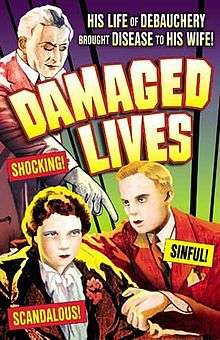Damaged Lives
| Damaged Lives | |
|---|---|
 | |
| Directed by | Edgar G. Ulmer |
| Produced by |
J. J. Allen (producer) Maxwell Cohn (producer) Nat Cohn (producer) |
| Written by |
Edgar G. Ulmer (screenplay) Donald Davis (dialog) |
| Based on |
play Les Avariés by Eugène Brieux (uncredited) |
| Starring | See below |
| Cinematography | Allen G. Siegler |
| Edited by | Otto Meyer |
Production company | |
| Distributed by |
Weldon Pictures Corporation Columbia Pictures |
Release dates |
22 May 1933 (Toronto, CAN) 19 August 1933 (London, UK) 15 September 1933 (Boston, USA) |
Running time | 61 minutes |
| Country | Canada, United States |
| Language | English |
| Budget | $18,000[1] |
Damaged Lives is a 1933 Canadian/American Pre-Code exploitation film directed by Edgar G. Ulmer.[2] The screenplay is based on the French play Les Avariés (1901) by Eugène Brieux.[3]
The film was shot at General Service Studios, Hollywood for the Canadian Social Health Council and premiered in Toronto.[4]
Damaged Lives was initially released in Canada and a few cities in the United States but was stopped by censors in most American towns. In 1937 the film was re-released as The Shocking Truth with a 29-minute supplementary lecture on VD added onto the end of the film to satisfy censors. Most current video releases do not include this extra material.[5]
Along with the controversial subject matter, the film is also noteworthy for containing one of the earliest filmed nude scenes in a sequence where a group of fun-loving women strip naked and go skinny dipping.
Plot summary
The film involves an extramarital encounter that leads the wife of the main character into killing herself and her husband.
A boss insists that a young executive, with an important job and a long term girlfriend, go out with him to a party and while out at the party he sleeps with a young wealthy woman, Elise (Charlotte Merriam), and contracts a dangerous venereal disease from her. The girlfriend is so upset that she commits suicide.
Cast
- Diane Sinclair as Joan Bradley
- Lyman Williams as Donald Bradley Jr.
- Harry Myers as Nat Franklin
- Marceline Day as Laura Hall
- Jason Robards Sr. as Dr. Bill Hall
- Charlotte Merriam as Elise Cooper
- Murray Kinnell as Dr. Vincent Leonard
- George Irving as Donald Bradley Sr.
- Cecilia Parker as Rosie
- Almeda Fowler as Mrs. Bradley
Production
Filmed in 1933, this cautionary tale was distributed under the name Weldon Pictures, because Columbia did not want to be associated with the topic of the film.[3] The end title of the Internet Archive print says the film was an Educational Film Exchanges, Inc. release.[6]
Although some scenes in the film were cut by state film censor boards in Maryland and Ohio, it was still very popular in the United States.[1] For example, in Baltimore 65,000 persons, representing approximately 10% of the population, saw the film.[1]
References
- 1 2 3 Schaefer, Eric (1999). "Bold! Daring! Shocking! True!": A History of Exploitation Films, 1919-1959. Duke University Press. pp. 180, 419. ISBN 0-8223-2374-5.
- ↑ Damaged Lives at the American Film Institute Catalog.
- 1 2 Bogdanovich, Peter (1997) Who the Devil made it : conversations with Robert Aldrich, George Cukor, Allan Dwan, Howard Hawks, Alfred Hitchcock, Chuck Jones, Fritz Lang, Joseph H. Lewis, Sidney Lumet, Leo McCarey, Otto Preminger, Don Siegel, Josef von Sternberg, Frank Tashlin, Edgar G. Ulmer, Raoul Walsh in libraries (WorldCat catalog) (New York: Knopf) ISBN 978-0-3454-0457-2
- ↑ Rist, Peter (2001). Guide to the Cinema(s) of Canada (Westport, Conn., and London: Greenwood Press), p. 77. ISBN 0-313-29931-5.
- ↑ Damaged Lives at AllMovie
- ↑ "Damaged Lives". Internet Archive. Retrieved 15 August 2016.
External links
- Damaged Lives at the Internet Movie Database
- Damaged Lives is available for free download at the Internet Archive